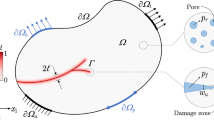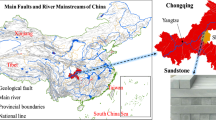Abstract
This paper investigates localized shear deformation around a borehole due to internal pressure in the well such as by fluid injection. Using an elasto-visco-plastic formulation combined with damage mechanics for the effect of shear cracking, we first benchmark the model against analytical solutions and then provide bifurcation criteria for the onset of localized cracking at different temperature conditions. We report that at increased temperatures of the rock formation, hot fluid injection promotes shear stimulation, while cold fluid suppresses it. This counter-intuitive result can offer new pathways of effective stimulation in high-temperature environments, like those encountered in enhanced geothermal systems.













Similar content being viewed by others
Abbreviations
- Ar :
-
Arrhenius number
- \(\alpha _{\mathrm{th}}\) :
-
Thermal expansion coefficient
- \(\beta _{\mathrm{damage}}\) :
-
Damage coefficient
- \(C_{ijkl}\) :
-
Fourth-order constitutive tensor
- \(c_{\mathrm{th}}\) :
-
Thermal diffusivity
- c :
-
Cohesion strength
- D :
-
Damage variable
- \(D^e_{ijkl}\) :
-
Elastic compliance tensor
- \(E_{ijkl}\) :
-
Elasticity tensor
- \(\delta\) :
-
Normalization coefficient for the temperature
- \(\epsilon _{ij}\) :
-
Strain tensor
- \(\dot{\epsilon }^{r}_{ij}\) :
-
Elastic (reversible) strain rate
- \(\dot{\epsilon }^{irr}_{ij}\) :
-
Plastic (irreversible) strain rate
- \(\dot{\epsilon }_0\) :
-
Reference strain rate
- \(\dot{\epsilon }^{irr}_{d}\), \(\dot{\epsilon }^{irr}_{v}\) :
-
Deviatoric and volumetric components of plastic strain rate
- f :
-
Yield function
- \(\phi _c\) :
-
Friction angle of the rock
- G :
-
Shear modulus
- Gr :
-
Gruntfest number
- k :
-
Yield stress in shear
- \(\dot{\lambda }\) :
-
Scalar multiplier
- M :
-
A function of the friction angle, \(M={\sin }\phi _c/(1-{\sin }\phi _c)\)
- m :
-
Exponent in the power law stress–strain relationship
- n :
-
Exponent in the damage evolution
- \(n_{i}, n_{j}\) :
-
Components of unit normal vector
- \(p', p_Y\) :
-
Mean (effective) normal stress and the value at yield
- \(p_f\) :
-
Pore fluid pressure
- \(Q_{\mathrm{mech}}, Q^d_{\mathrm{mech}}, Q^V_{\mathrm{mech}}\) :
-
Activation enthalpy for mechanics, deviatoric and volumetric components of activation energy
- \(q, q_Y\) :
-
Equivalent deviatoric stress and the value at yield
- R :
-
Universal gas constant
- T :
-
Temperature
- \(\tau _{ik}\) :
-
Acoustic tensor
- \(\theta\) :
-
Shear band inclination angle
- \(\sigma _{ij}\) :
-
Stress tensor
- \(\sigma _{\mathrm{in}}, \sigma _{\mathrm{out}}\) :
-
Applied radial stress on the inner and outer boundaries
- \(\sigma _{\theta 0,S}\) :
-
Critical value of the circumferential stress at the borehole wall for surface instability mode
- \(t^{\star }\), \(x^{\star }\), \(T^{\star }\), \(\Delta p^{\star }\), \(\sigma ^{\star }_{ij}\) :
-
Normalized variables of time, space, temperature, pore pressure increase, stress
- \(\mu\) :
-
Slope of the Drucker–Prager yield surface in \(p'-q\) coordinates
References
Alevizos S, Poulet T, Veveakis E (2014) Thermo-poro-mechanics of chemically active creeping faults. 1: Theory and steady state considerations. J Geophys Res Solid Earth 119(6):4558–4582
Balay S, Abhyankar S, Adams M, Brown J, Brune P, Buschelman K, Eijkhout V, Gropp W, Kaushik D, Knepley M et al (2014) Petsc users manual revision 3.5. Argonne National Laboratory (ANL)
Bigoni D, Hueckel T (1991a) Uniqueness and localization—i. associative and non-associative elastoplasticity. Int J Solids Struct 28(2):197–213
Bigoni D, Hueckel T (1991b) Uniqueness and localization—ii. coupled elastoplasticity. Int J Solids Struct 28(2):215–224
Chabora E, Zemach E, Spielman P, Drakos P, Hickman S, Lutz S, Boyle K, Falconer A, Robertson-Tait A, Davatzes NC et al (2012) Hydraulic stimulation of well 27–15, desert peak geothermal field, nevada, usa. In: Proceedings of thirty-seventh workshop on geothermal reservoir engineering, Stanford University, Stanford. Vol. 30
Dempsey D, Kelkar S, Davatzes N, Hickman S, Moos D (2015) Numerical modeling of injection, stress and permeability enhancement during shear stimulation at the desert peak enhanced geothermal system. Int J Rock Mech Min Sci 78:190–206
Dempsey D, Kelkar S, Lewis K, Hickman S, Davatzes N, Moos D, Zemach E et al (2013) Modeling shear stimulation of the desert peak egs well 27–15 using a coupled thermal-hydrological-mechanical simulator. In: 47th US Rock mechanics/geomechanics symposium. American Rock Mechanics Association
Gaston D, Newman C, Hansen G, Lebrun-Grandie D (2009) Moose: a parallel computational framework for coupled systems of nonlinear equations. Nucl Eng Des 239(10):1768–1778
Ghassemi A, Kelkar S, McClure M (2015) Influence of fracture shearing on fluid flow and thermal behavior of an egs reservoir-geothermal code comparison study. In: Proceedings of the 40 th workshop on geothermal reservoir engineering, pp 26–28
Girard L, Bouillon S, Weiss J, Amitrano D, Fichefet T, Legat V (2011) A new modeling framework for sea-ice mechanics based on elasto-brittle rheology. Ann Glaciol 52(57):123–132
Johnson W, Sowerby R, Venter R, Kobayashi S (1983) Plane-strain slip-line fields for metal-deformation processes. J Appl Mech 50:702
Kachanov M (1994) On the concept of damage in creep and in the brittle-elastic range. Int J Damage Mech 3(4):329–337
Karrech A, Regenauer-Lieb K, Poulet T (2011) Continuum damage mechanics for the lithosphere. J Geophys Res Solid Earth 116(B4). doi:10.1029/2010JB007501
Kirk BS, Peterson JW, Stogner RH, Carey GF (2006) libmesh: a c++ library for parallel adaptive mesh refinement/coarsening simulations. Eng Comput 22(3–4):237–254
Lemaitre J, Chaboche J-L (1978) Aspect phénoménologique de la rupture par endommagement. J Méc Appl 2(3):317–365
Lutz SJ, Hickman S, Davatzes N, Zemach E, Drakos P, Robertson-Tait A (2010) Rock mechanical testing and petrologic analysis in support of well stimulation activities at the desert peak geothermal field, nevada. In: Proceedings 35th workshop on geothermal reservoir engineering
McClure M, Horne R et al (2014) Characterizing hydraulic fracturing with a tendency-for-shear-stimulation test. SPE Reserv Eval Eng 17(02):233–243
Paesold M, Bassom A, Regenauer-Lieb K, Veveakis M (2016) Conditions for the localisation of plastic deformation in temperature sensitive viscoplastic materials. J Mech Mater Struct 11(2):113–136
Papamichos E (2010) Analysis of borehole failure modes and pore pressure effects. Comput Geotech 37(1):141–152
Papamichos E, Vardoulakis I, Tronvoll J, Skjaerstein A (2001) Volumetric sand production model and experiment. Int J Numer Anal Methods Geomech 25(8):789–808
Poulet T, Paesold M, Veveakis M (2017) Multi-physics modelling of fault mechanics using redback: a parallel open-source simulator for tightly coupled problems. Rock Mech Rock Eng 50(3):733–749
Poulet T, Veveakis M (2016) A viscoplastic approach for pore collapse in saturated soft rocks using redback: an open-source parallel simulator for rock mechanics with dissipative feedbacks. Comput Geotech 74:211–221
Regenauer-Lieb K, Bunger A, Chua HT, Dyskin A, Fusseis F, Gaede O, Jeffrey R, Karrech A, Kohl T, Liu J et al (2015) Deep geothermal: The ’moon landing’ mission in the unconventional energy and minerals space. J Earth Sci 26(1):2–10
Regenauer-Lieb K, Yuen D (2003) Modeling shear zones in geological and planetary sciences: solid-and fluid-thermal-mechanical approaches. Earth Sci Rev 63(3):295–349
Rice JR, Lapusta N, Ranjith K (2001) Rate and state dependent friction and the stability of sliding between elastically deformable solids. J Mech Phys Solids 49(9):1865–1898
Vardoulakis I, Papanastasiou P (1988) Bifurcation analysis of deep boreholes: I. surface instabilities. Int J Numer Anal Methods Geomech 12(4):379–399
Veveakis E, Alevizos S, Vardoulakis I (2010) Chemical reaction capping of thermal instabilities during shear of frictional faults. J Mech Phys Solids 58(9):1175–1194
Veveakis E, Regenauer-Lieb K (2015) Cnoidal waves in solids. J Mech Phys Solids 78:231–248
Zoback MD (2007) Reservoir Geomechanics: Earth stress and rock mechanics applied to exploration, production and wellbore stability. Cambridge University Press, Cambridge. doi:10.1017/CBO9780511586477
Acknowledgements
The authors would like to thank Sotiris Alevizos for stimulating discussions. This work was supported through the close collaboration between UNSW Australia and CSIRO under the auspices of an Unconventional Resources Research Initiative. K. Regenauer-Lieb, T. Poulet and M. Veveakis were also supported by the Australian Research Council (ARC Discovery Grants No. DP140103015, DP170104557).
Author information
Authors and Affiliations
Corresponding author
Appendices
Appendix A: Case Study for Damage Mechanics During Loading and Unloading
A simple numerical case study on a square body is presented here to illustrate the damage mechanisms described in Sect. 2.3 under loading and unloading tests. The boundary conditions are summarized in Fig. 14. The left boundary of the body is fixed, while the top and the bottom are free boundaries. On the right boundary, as shown in Fig. 14, uniformly distributed stress is applied and only horizontal displacement is allowed. The material is assumed pressure insensitive, and the evolution of internal damage variable (representing local concentration of micro-cracks within the material) follows Eq. 11.
Figure 15a demonstrates the stress–strain curve obtained from loading–unloading procedures. In the loading phase, the modified Young’s modulus of the body, i.e. the slope of the stress–strain curve, decreases due to internal damage evolution with local \(\dot{D}\) being positive (see Eq. 11, Eq. 12b). No damage evolution occurs during the unloading phase, and hence, the corresponding stress–strain curve is linear, meaning a constant elastic modulus. The residual strain (small but still visible from Fig. 15a) after the loading–unloading cycle results largely from (irreversible) micro-cracking processes in the material. Damage evolution with respect to normalized time and normalized strain is shown in Fig. 15b, c, respectively. The middle point of the square body is chosen as a representative. The damage increases during loading as \(\dot{D}\) stays positive, while it remains a constant during unloading since no micro-cracking occurs.
Appendix B: Derivation of the Bifurcation Characteristic Equation
The incremental constitutive equation in tensorial form is expressed as
The stiffness tensor \(C_{ijkl}\) in 2D configuration has the following properties:
For elasto-plastic material, constitutive Eq. 24 is more often rewritten as
where \(L_{ij}\) are coefficients dependent on material properties and hardening parameters, including friction coefficient, dilatancy coefficient, hardening modulus, etc. Eq. 24 reads
Combining Eq. 26 and Eq. 27, with Eq. 25, we have
Hence, the condition for localization Eq. 19 can be written as
that is,
Substituting \({\mathrm{tan}} \theta = -(n_1/n_2)\) (\(\theta\) being the shear band inclination angle) into Eq. 30, we have the characteristic Eq. 20.
Rights and permissions
About this article
Cite this article
Hu, M., Veveakis, M., Poulet, T. et al. The Role of Temperature in Shear Instability and Bifurcation of Internally Pressurized Deep Boreholes. Rock Mech Rock Eng 50, 3003–3017 (2017). https://doi.org/10.1007/s00603-017-1291-2
Received:
Accepted:
Published:
Issue Date:
DOI: https://doi.org/10.1007/s00603-017-1291-2






